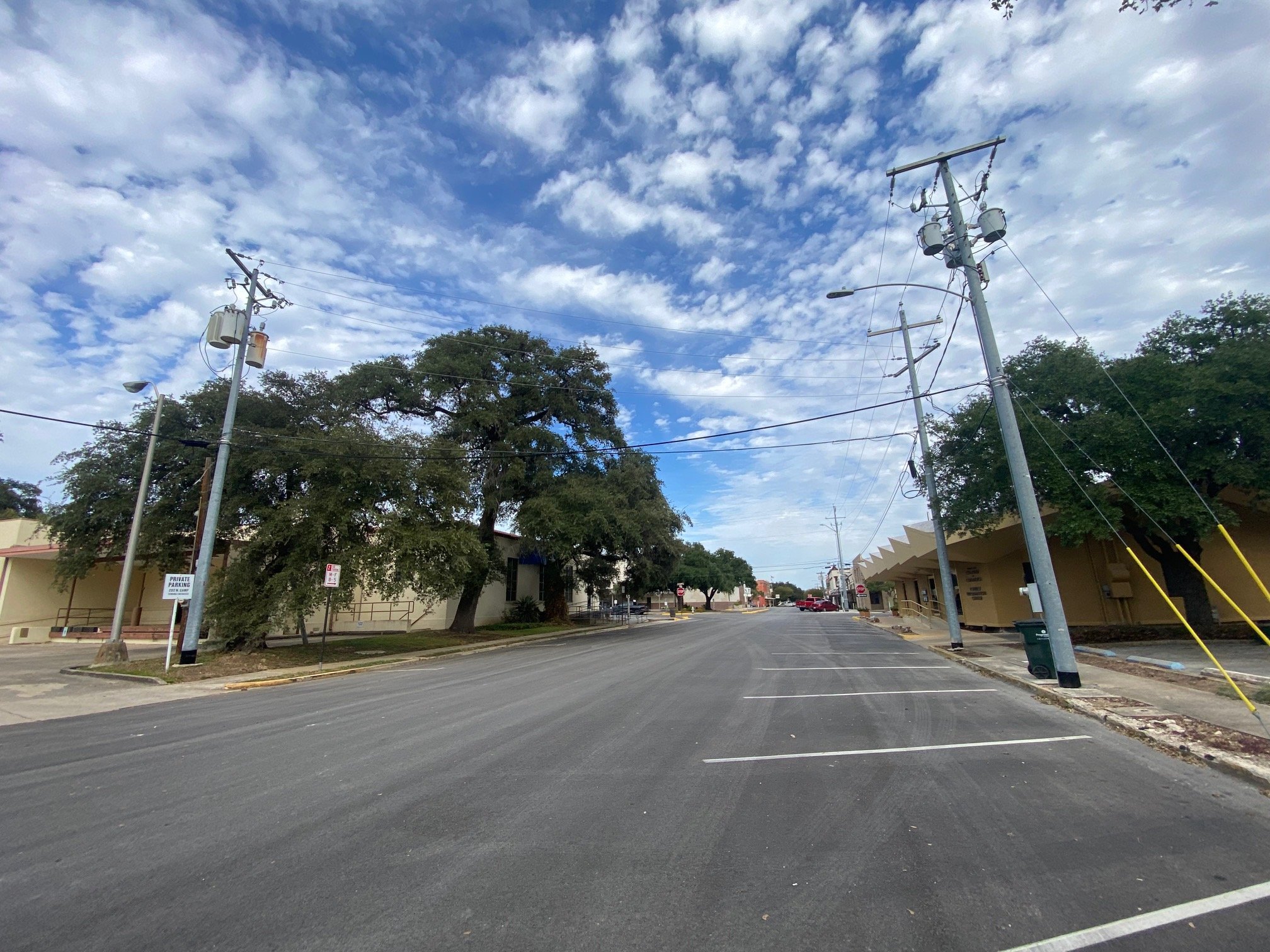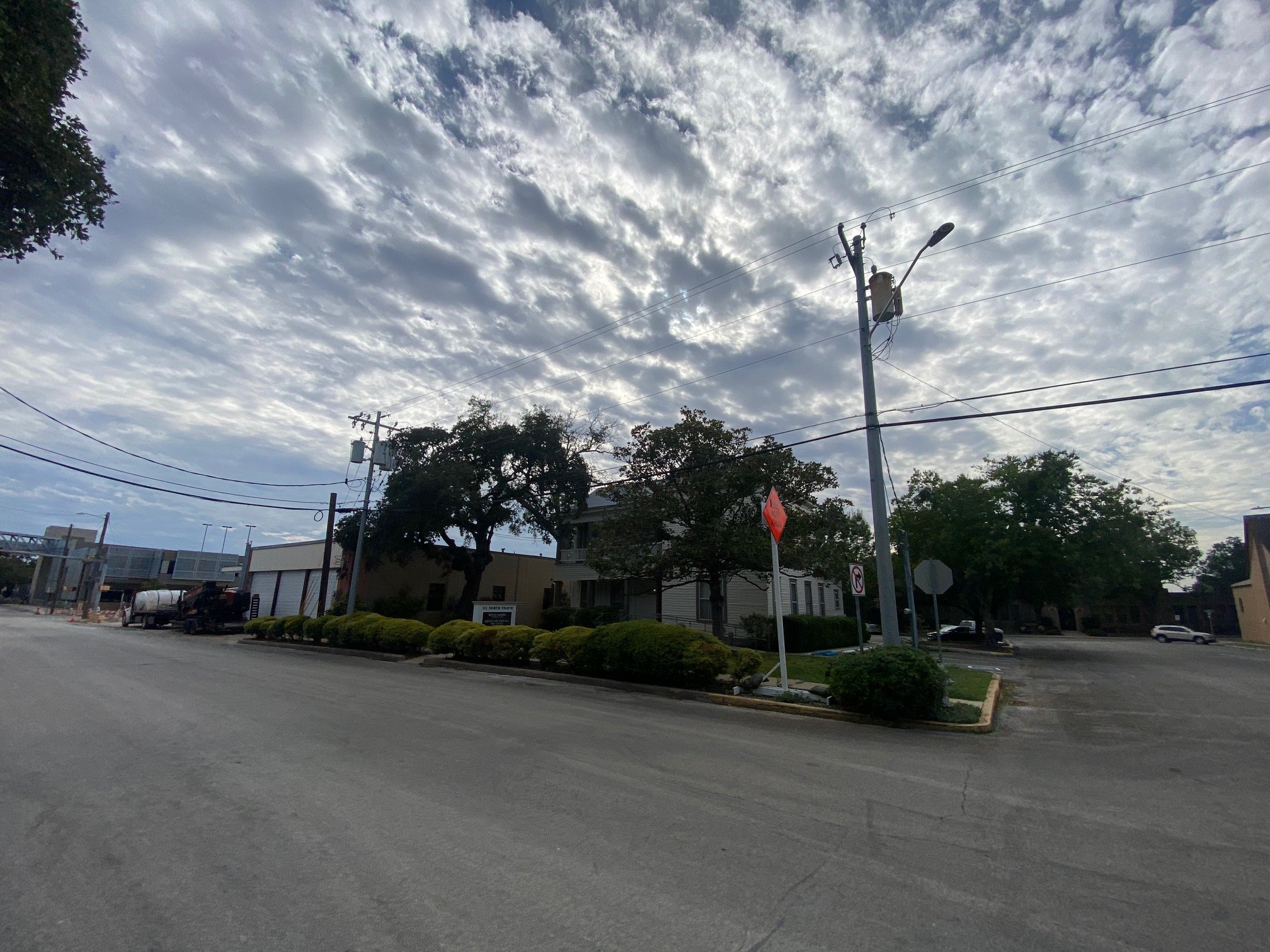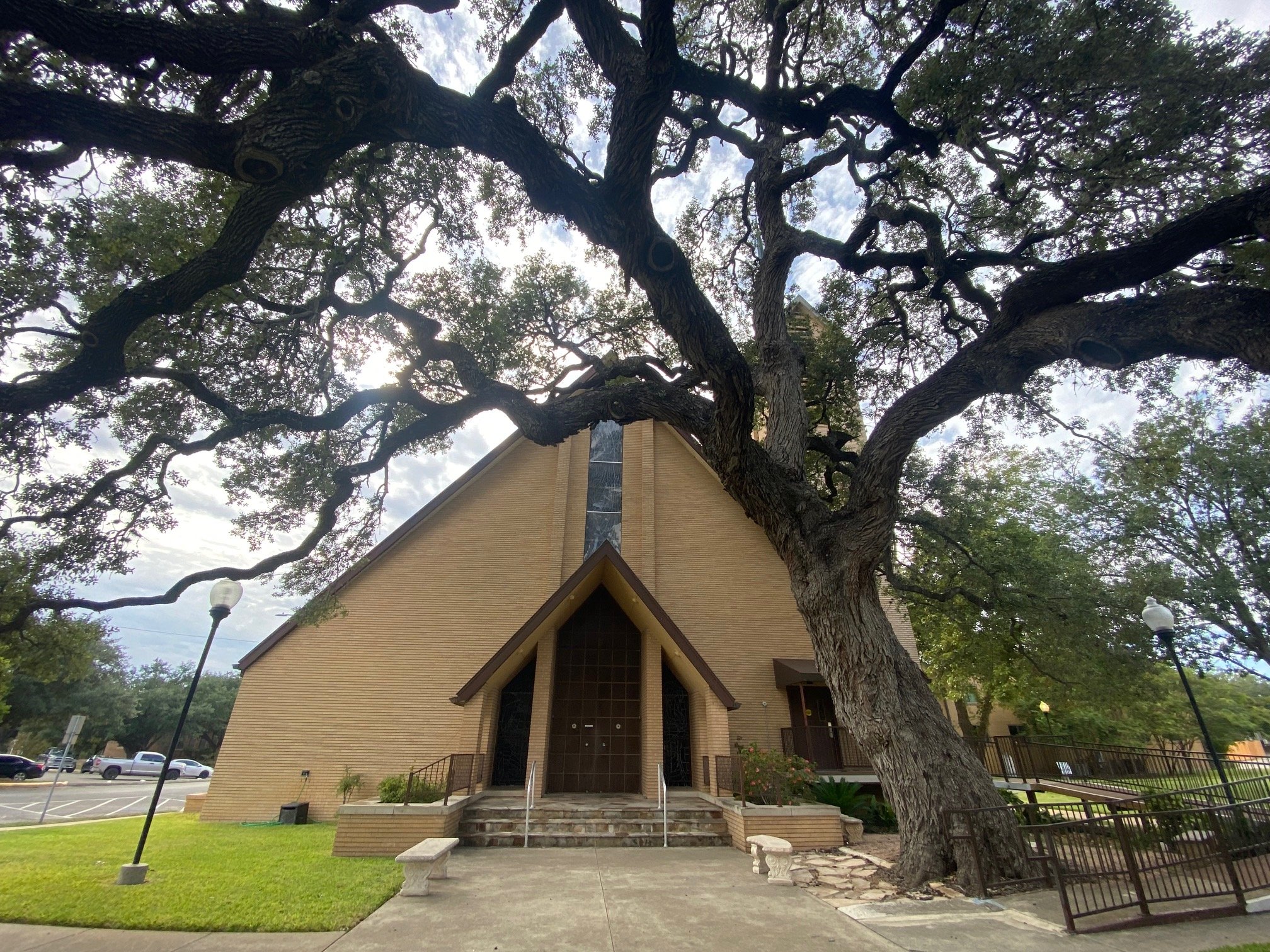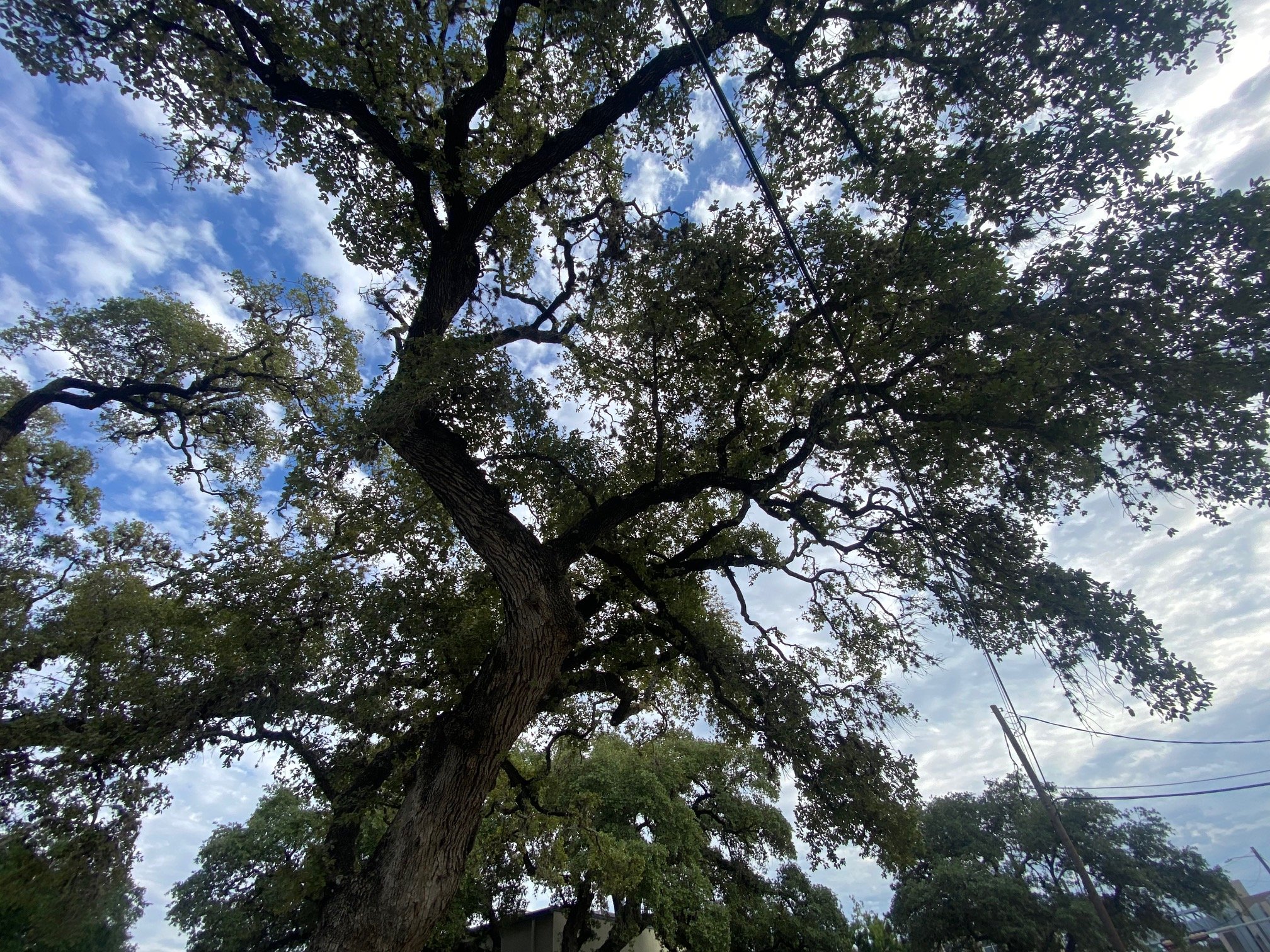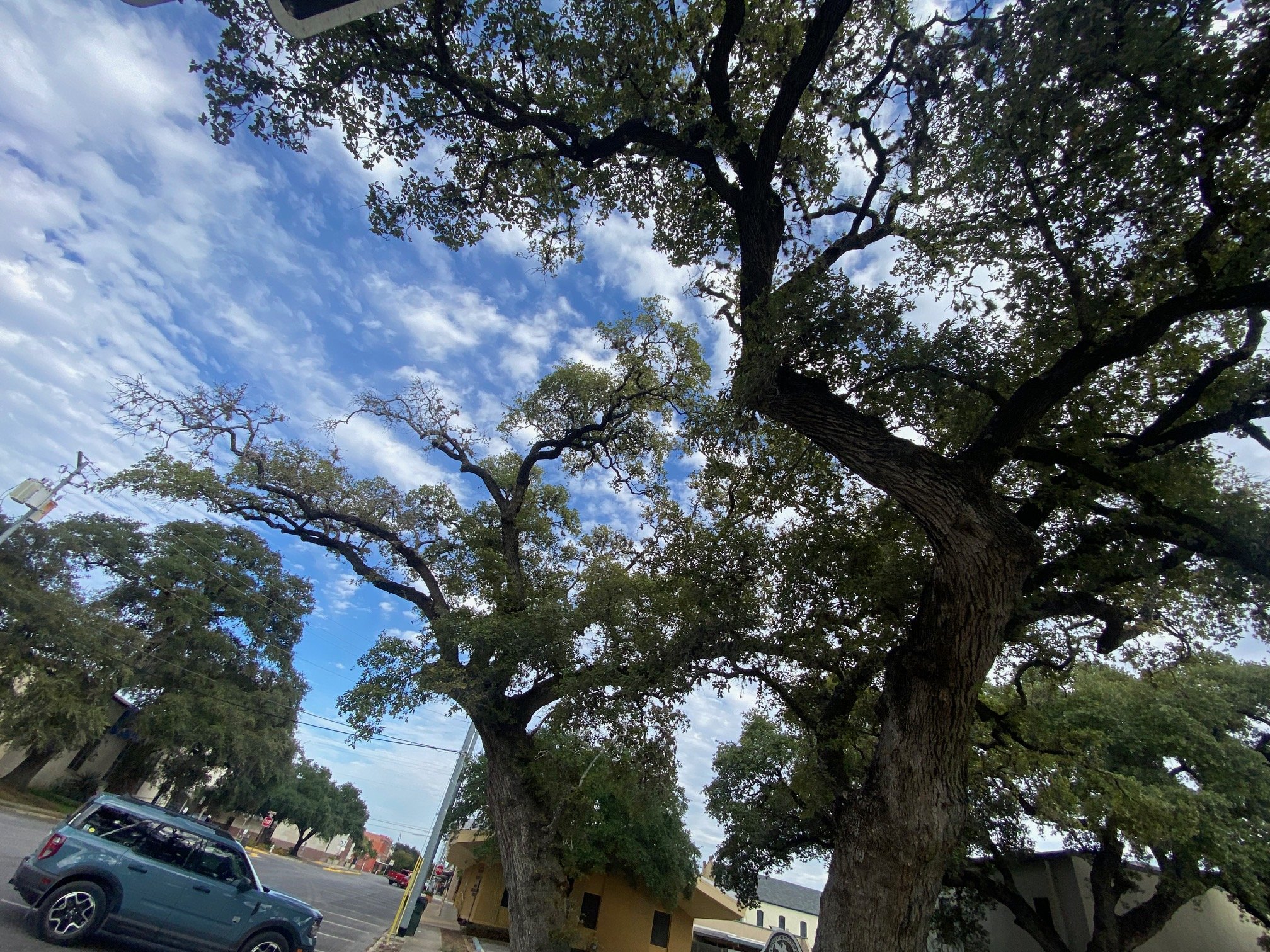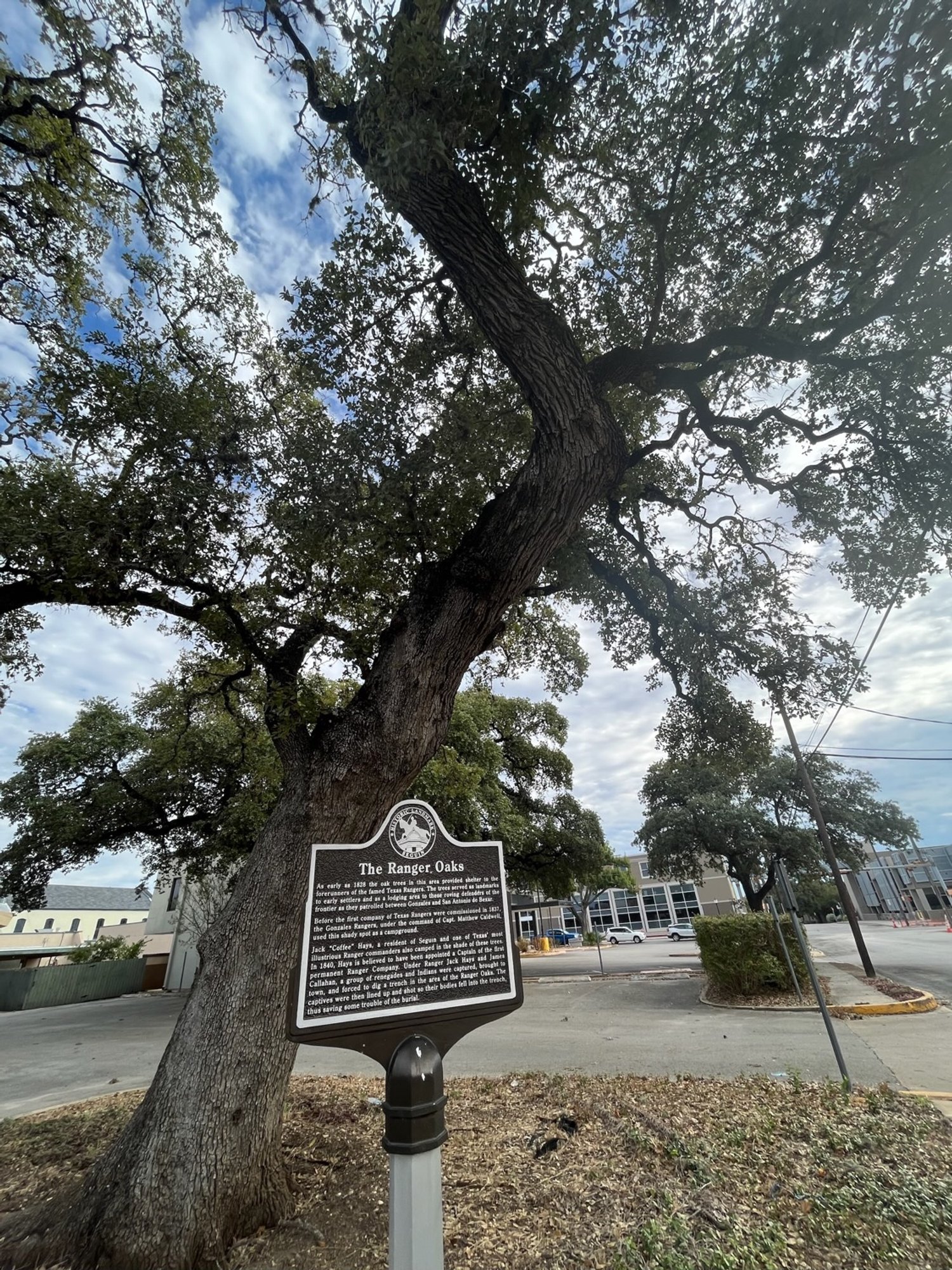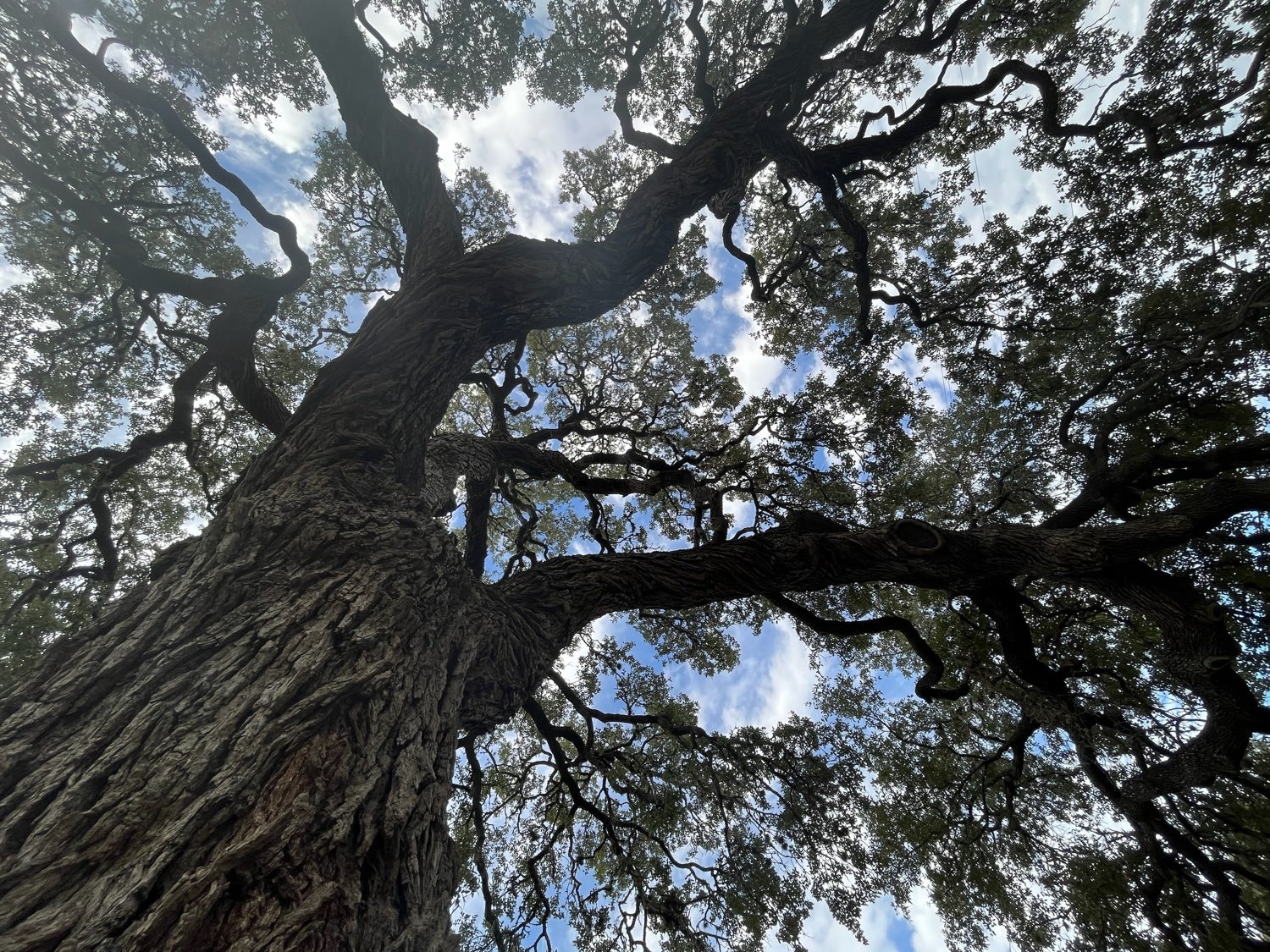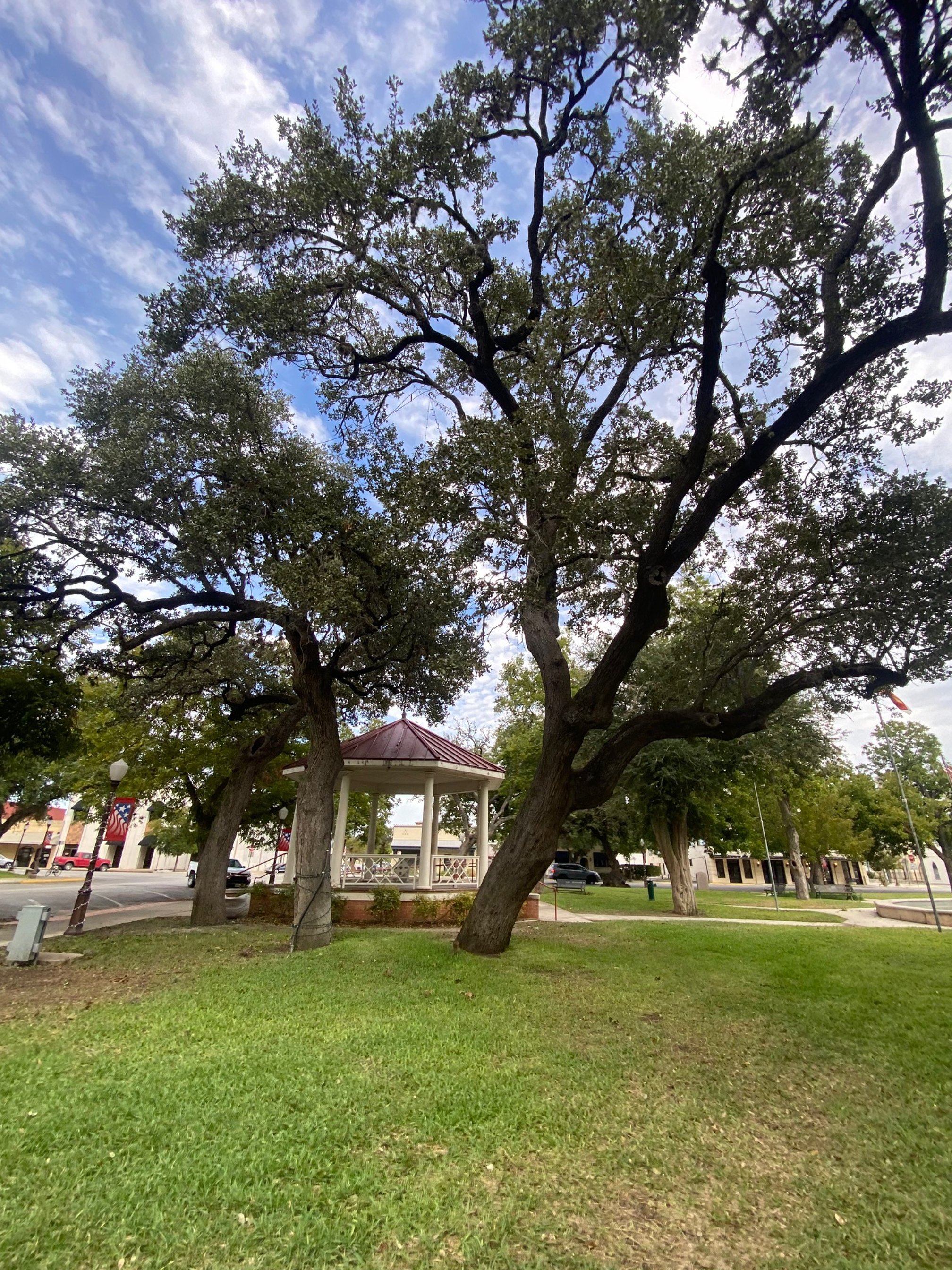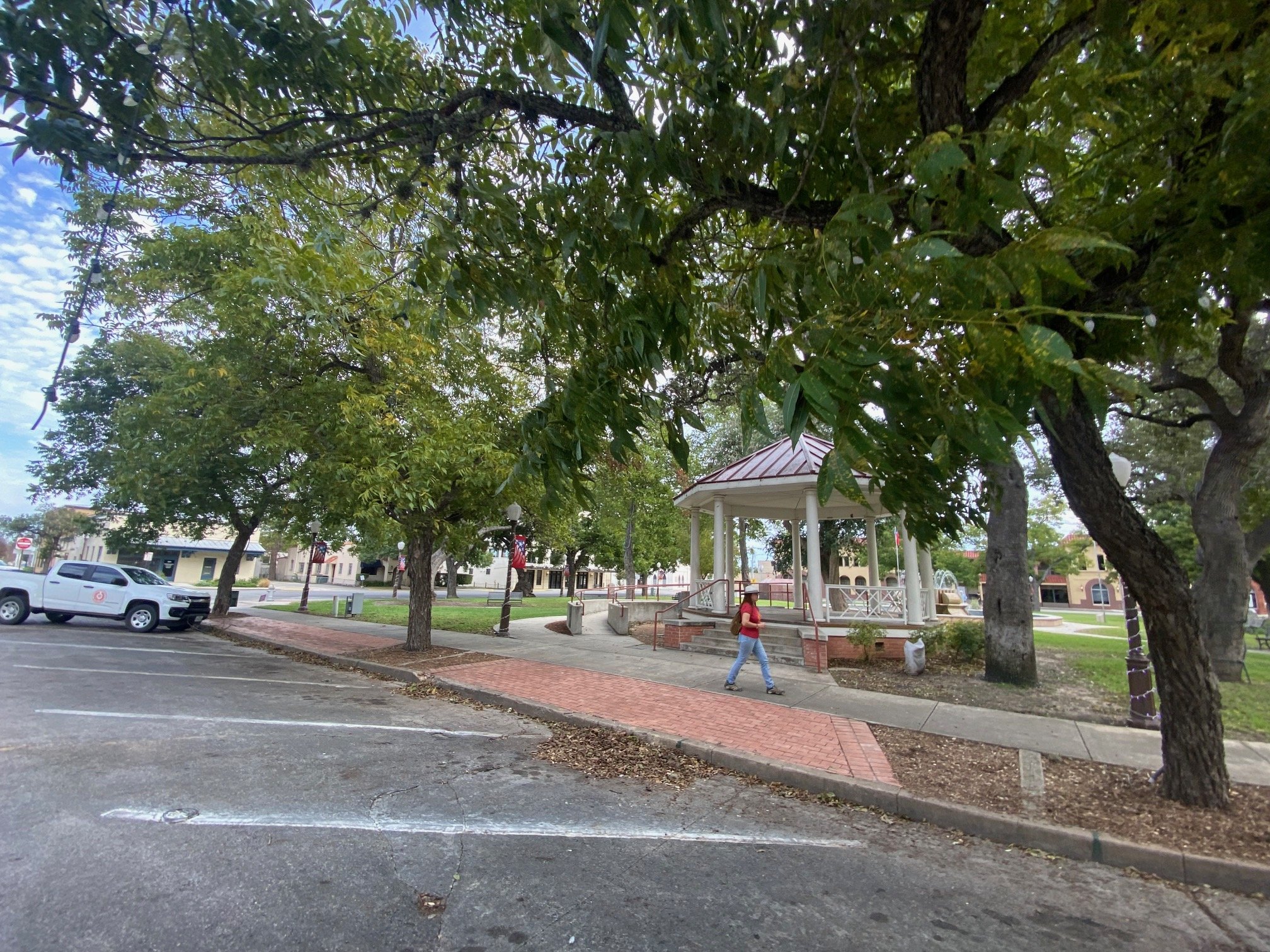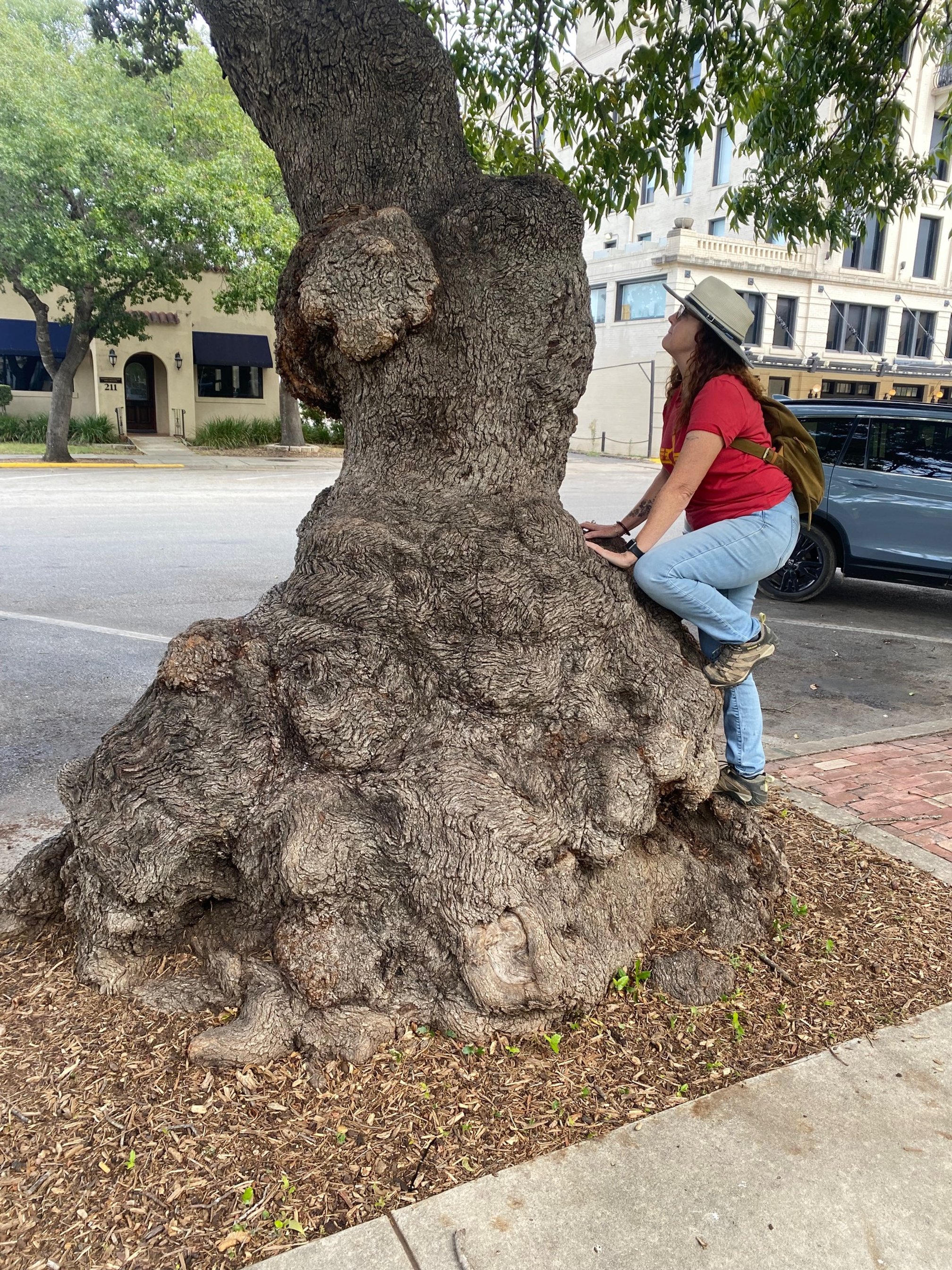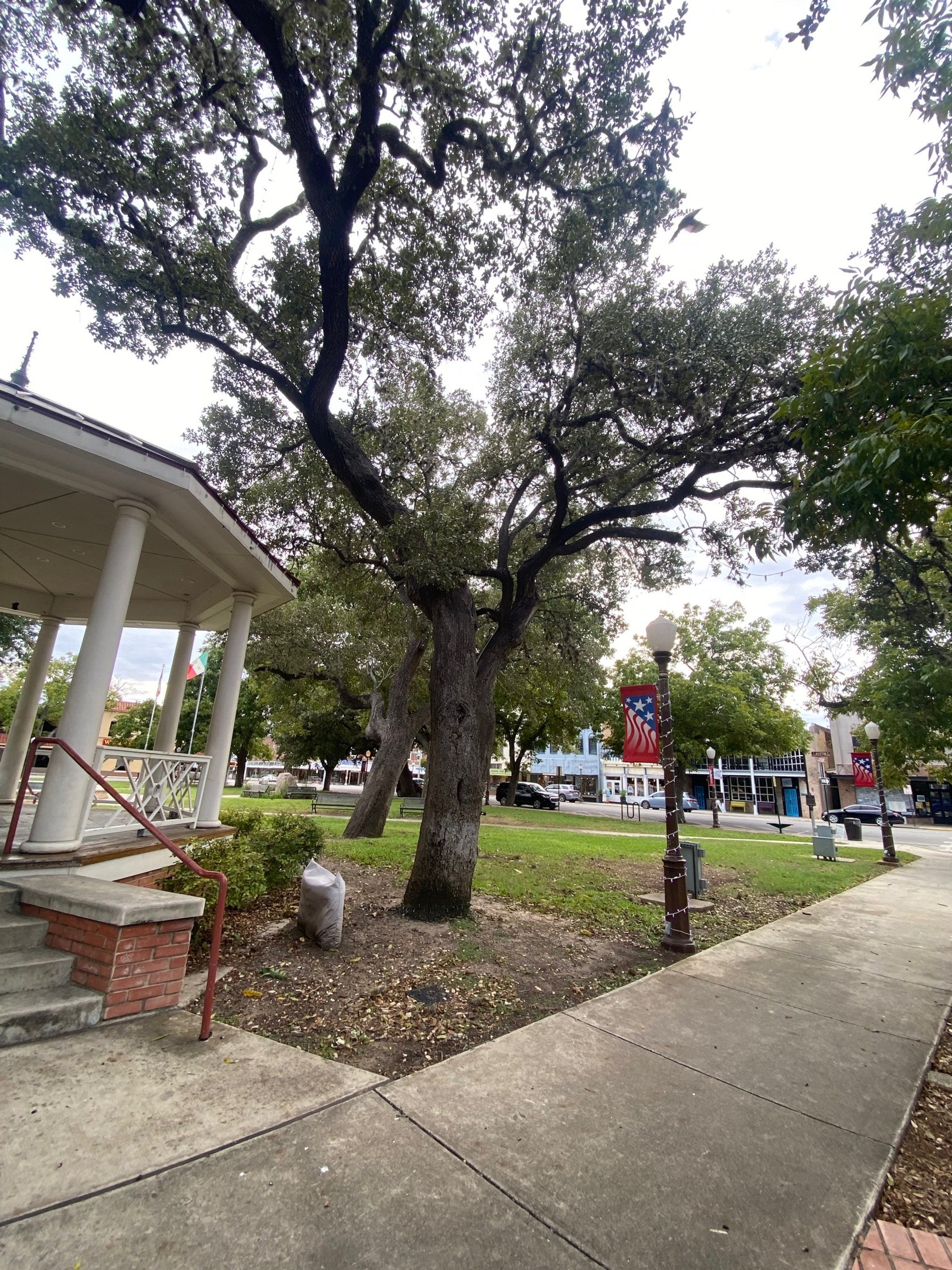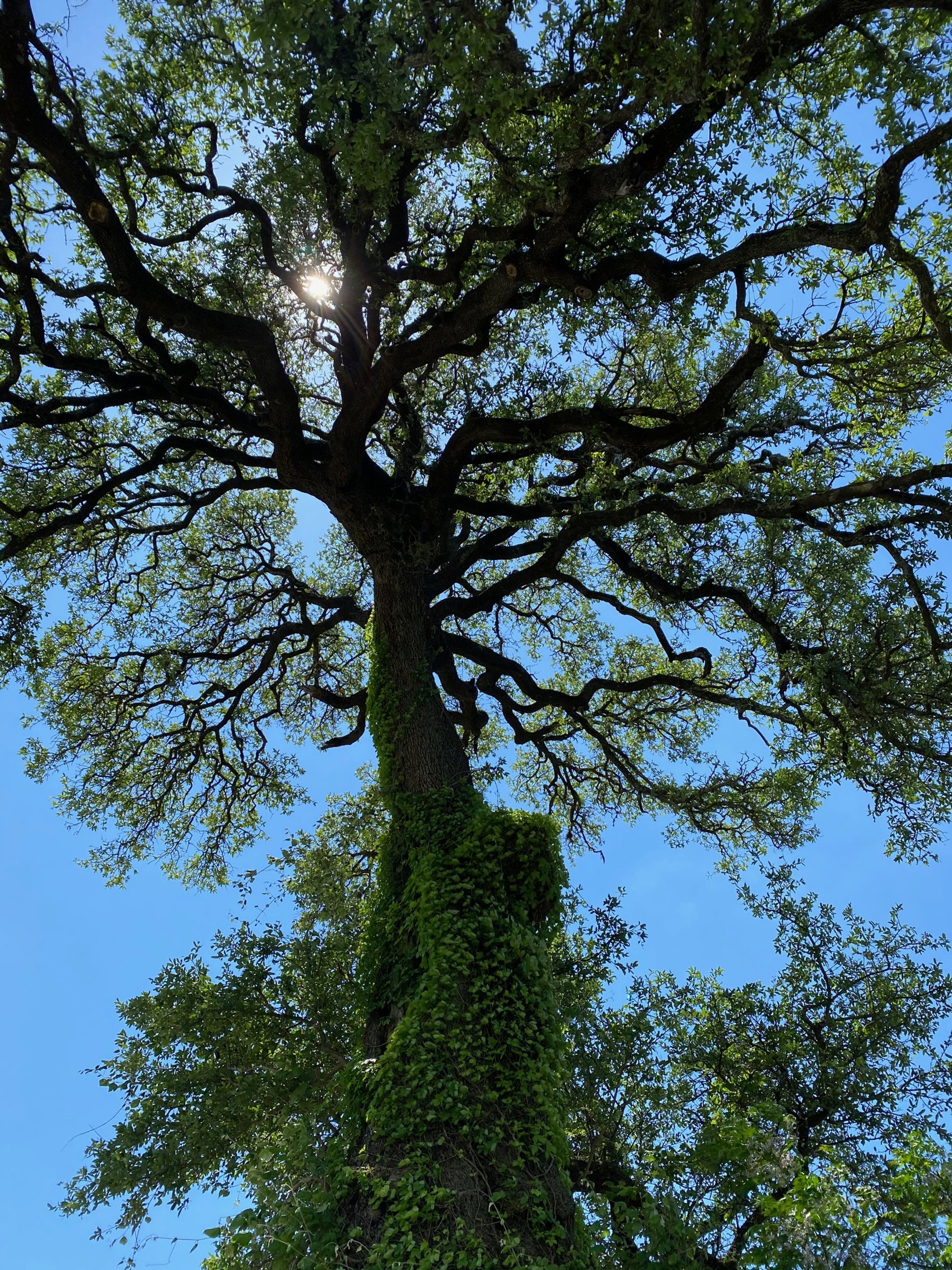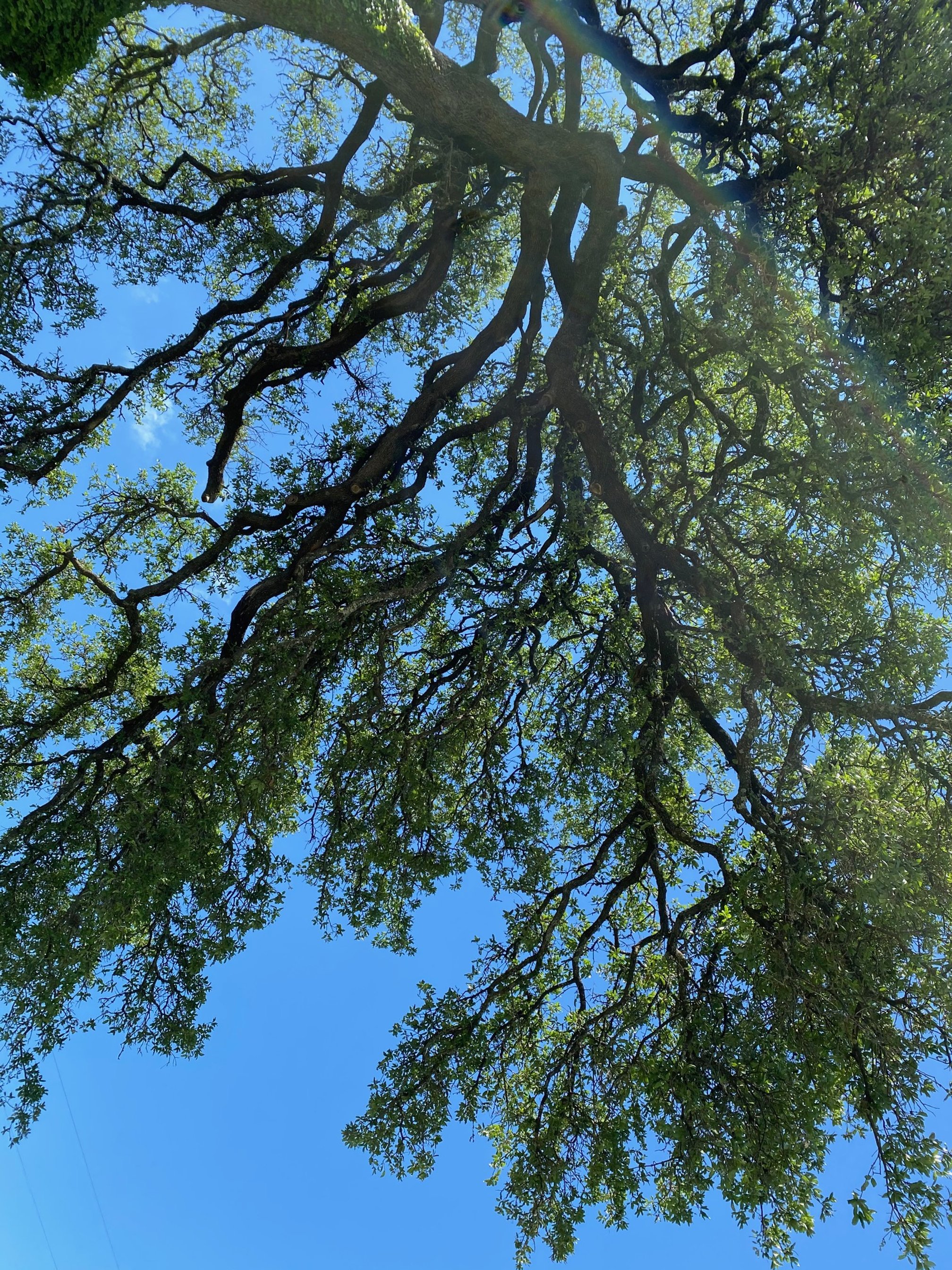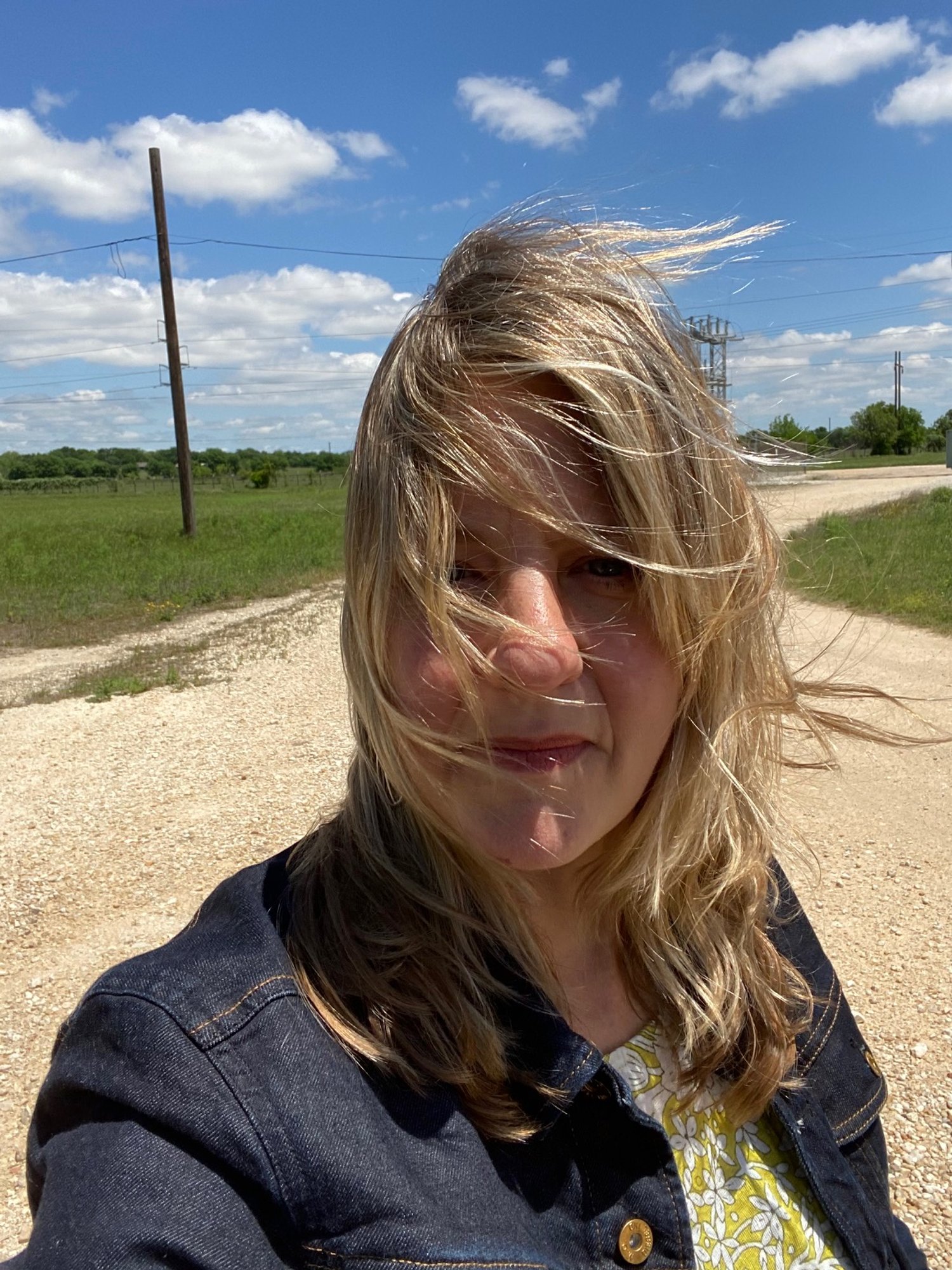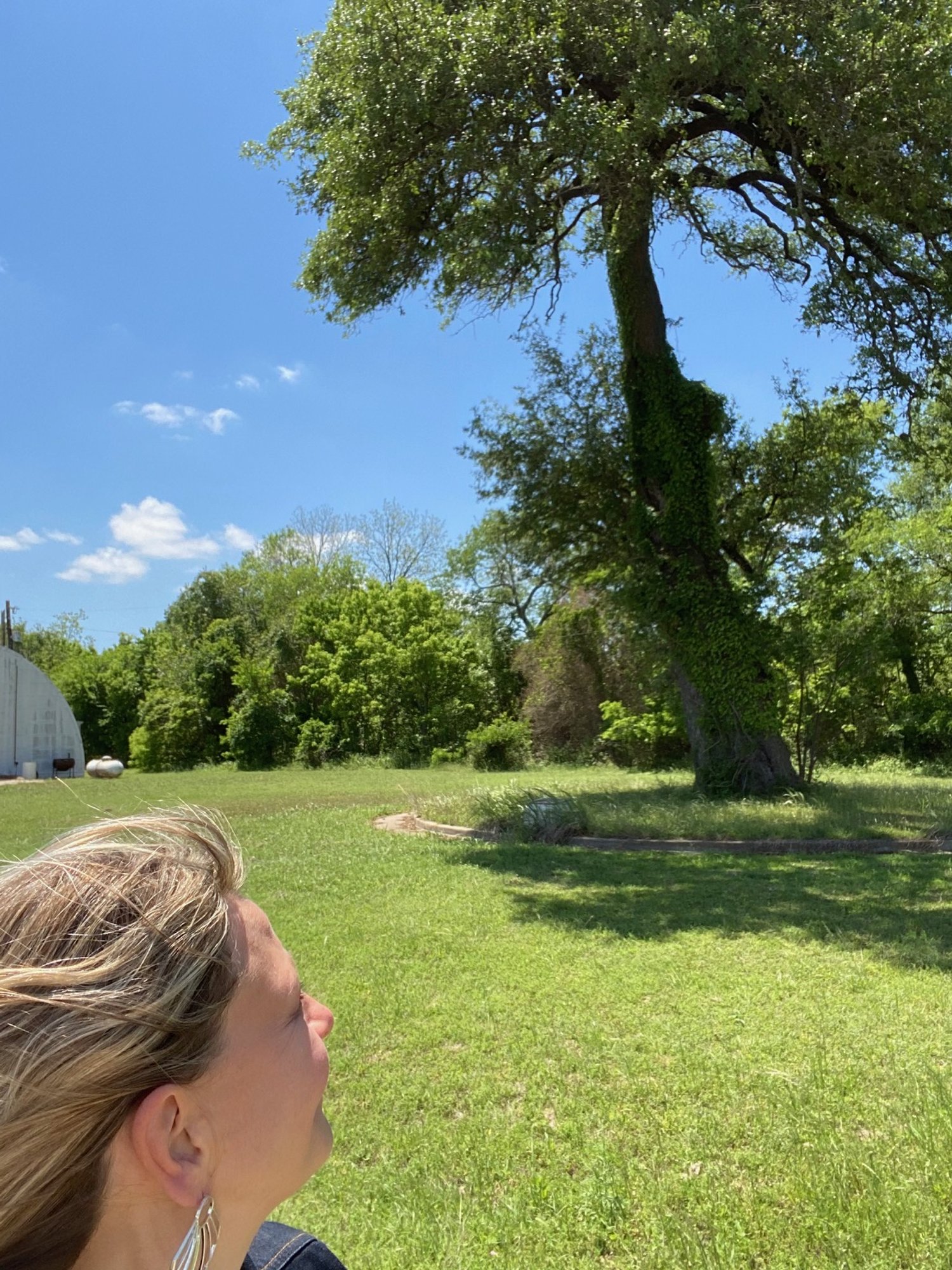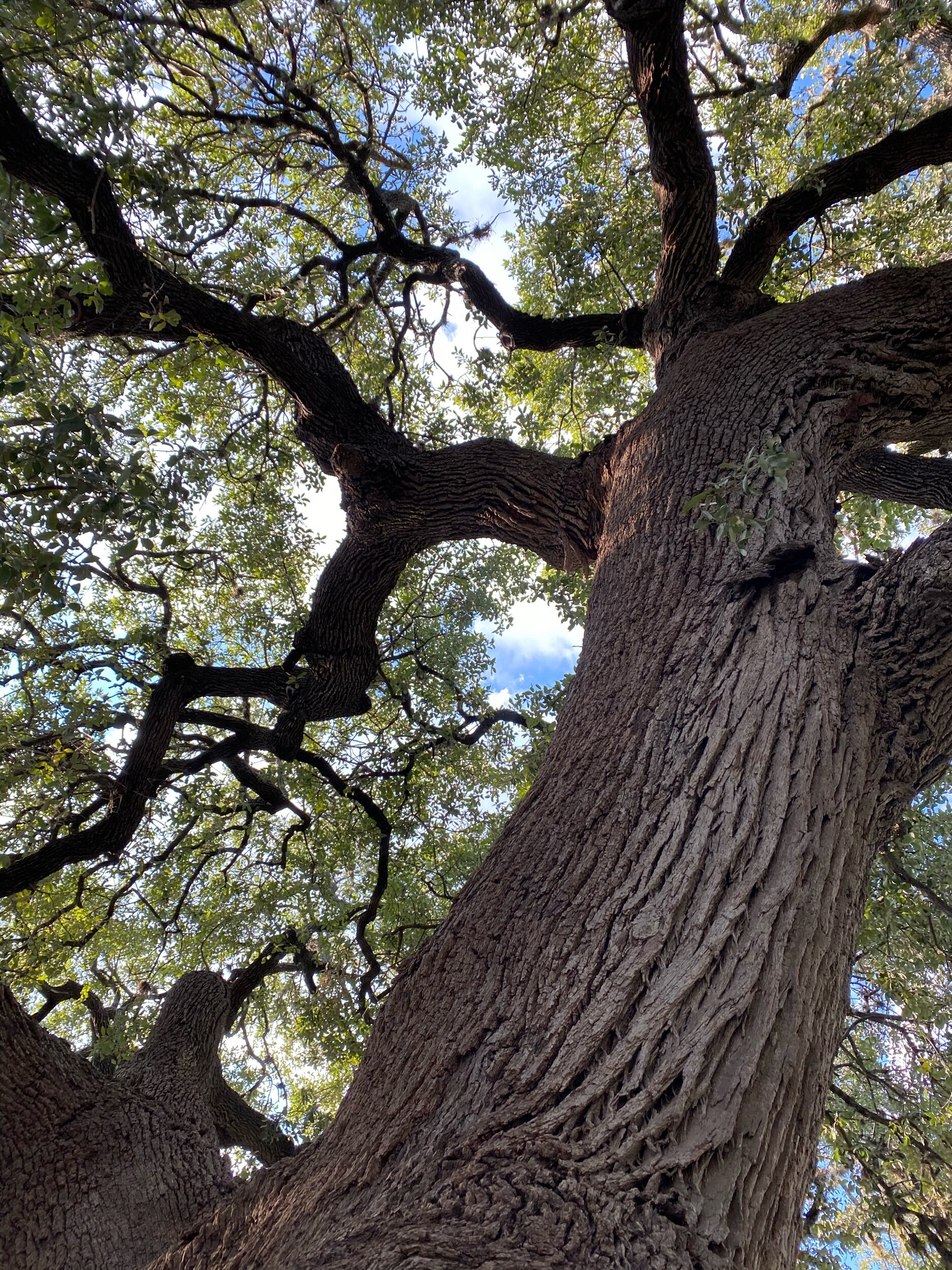
Ranger Oaks
Not gonna lie. When I saw these two scraggly oaks, I was disappointed.
Not gonna lie. When I saw these two scraggly oaks, I was disappointed.
Finding historic oaks that look forgotten, declining, and degraded by municipal structure is downright depressing.
Other notable oak siblings, with their roots squelched into oblong cement shapes, stood in the vicinity on the first cool weekend of October.
Before it was a parking lot…
this area of downtown Seguin was a whole grove of trees under which the Gonzales Rangers — precursor of the Texas Rangers — took shelter circa 1828.
The historical marker describes a disturbing firing line massacre…
of Indians and other “renegades” shot so their bodies fell into the trench they were forced to dig themselves beforehand, which “saved some of the trouble of the burial.”
Great imagery. Thanks
Glad we got that engraved on a sign for posterity.
I’ll go ahead and admit that it didn’t even occur to me
while we were standing there, that the cement and asphalt I was fussing about covers the mass grave that the marker details. Recounted in devastating detail from a different perspective, this article names Ranger James Callahan from the celebratory plaque, which was appallingly placed there as late as 2010.
Looking into it later led me down a rabbit hole which included this podcast about the dark chapters in the history of the Texas Rangers.
On a more uplifting note, an impressive larger specimen caught our eye, catty corner from where we parked, so my friend, former co-worker, Texas Master Naturalist and fellow horticulturist, Sandi and I criss-crossed right on over to the Emmanuel Lutheran campus to get a look.
Now that’s more like it!
THIS is what keeps me driving around Texas: hoping I find a beautiful, mature giant that inspires awe and connects me to something greater than myself.
photo by Sandi Holmes
Who doesn’t LOVE a big ol’ tree with a satisfying trunk you can’t even get your arms around?
I mean, the city of Seguin paved up to the trunks of these old oaks, so… I don’t know
This photo accidentally captured the angle of the oaks shown in the first edition Famous Trees of Texas book
The Ranger Oaks are located at the southeast corner of Gonzales and Travis Streets, in Seguin.
Relevant links
Refusing to Forget is a multifaceted project that seeks to incite public conversations through efforts such as: museum and online exhibits, historical marker unveilings, lectures, and curricular materials for public school teachers. The story of Rangers executing unnamed men who had escaped slavery in March 1839 is linked from their site
Produced by Texas Monthly, the podcast White Hats tells the story of one of Texas’s defining symbols.
McNay Art Museum, in San Antonio has a drawing of oaks in Seguin from 1848
Many thanks to Brenda Biggerstaff-Sanchez for research assistance 🩷
Whipping Oak
Not ever completely sure which was the right tree, this was a mostly clueless stroll around the Guadalupe County courthouse grounds
This confusing jaunt might’ve been less so had I done my homework ahead of time, but that’s not how I roll.
By now, I have saved all the living trees on my google map app, so I rarely bother to look at the book or even the website. GPS coordinates and the brief location info is saved so I just go, frequently stumbling around to find what I’m looking for.
After hunting down the Ranger Oaks, I saw it was a couple blocks to the Guadalupe County courthouse in the same little town of Seguin to find another.
They were all in the same historic grove.
The gleaming limestone courthouse was easy enough to spot, but I had no idea which tree was the Whipping Oak. There were several surrounding a central plaza across the street.
The description said “near the gazebo,” but the unimpressive trees next to it didn’t seem right. We wandered around looking.
This marker was no help, pointing instead to a WPA built fountain project dedicated to the mayor who allocated resources to preserve it.
Happily, we noticed this wonderfully knarled live oak on one end of the plaza and spent a few minutes admiring the swirly, burl-like patterns in the bark.
Did you know that Seguin is home of the Worlds Largest Pecan?
I didn’t and I’m sorry to say that we never wandered around to the other side of the courthouse to find this kitschy gem.
Also interesting that the courthouse seems to have been beautifully power-washed since this 2019 photo I found on Google.
Thanks to Sara Neave!
While noodling around, I had been trying to look up the FToT page on my phone to see if it would lead us to the “right” tree.
Then I hear Sandi, “I FOUND IT.”
Named for the public punishment the tree played a part in, these iron loops provided a hitch for tying up “runaway slaves, thieves, and wife-beaters” before lashing them.
Now the tree itself gets punished: slow strangulation by xmas lights.
The Whipping Oak stands near the gazebo across from the south entrance to the Guadalupe County courthouse.
Bell County Charter Oak
Under this damaged live oak, now overlooking a power center, the first election was held in 1850 to organize the new Bell County
The old description mentions the Leon River, which I never saw. And private property, which I also knew nothing about until much later.
I believe I acted pretty respectfully. It seemed more or less public. When I drove up the gravel road using google coordinates, a bunch of softball players gathered near a backstop stared at my vehicle as I headed over near a power station thing — what are those called? —where I could see the oak from a distance.
Now within an electric cooperative enclosure, this tree can be viewed from Charter Oak Drive on the east bank of the Leon River, in Belton, TX.
The 2015 edition of the Famous Trees of Texas has updated location information not available on the FToT website.
Even though it can damage tree roots, people seem to desire a ring of concrete around an “official tree.”
It’s obvious from the pictures that a strong wind was blowing. This was a quick visit. I snapped photos and high-tailed it out of there.
Kissing Tree
Though it has been there longer than anything in the vicinity, the moss-laden Kissing Tree looks out of place
We celebrate the early days of love: first dates, first kisses, love songs, engagement parties…
This oak, named because of its “popularity among couples” and for the numerous proposals that occurred under its boughs, is not the only historic tree whose story involves kissing, marriage proposals or schemes to make love remain true.
During the long slog of my divorce, which took almost 2 years, I obsessed on song lyrics, searching for my story of betrayal in song form. (Actually, I still do this). Pay attention to the lyrics of sweet, happy songs; they’re about the beginnings of youthful unions. Not hard to understand why songs about middle age separations do not sell. Even breakup songs rarely include details from decades-long relationships with custody issues, shared pets, mortgages…
(Ok, well I mean, country songs get into it).
Coming directly from lunch under the huge oaks at Beck’s Prime in Houston, winding a path back toward Dallas, my kid and I followed google maps to a gas station and parked a little away from the pumps, easily spotting the Kissing Tree from a distance.
I know I keep saying this, but seeking adventure in travel and repeatedly finding a barely altered version of the exact same places that you see at home anywhere in the U.S. — corporate restaurants, gas stations, dental chains, identical housing developments — it’s disheartening to say the least.
Though it has been there longer than anything in the vicinity, the Kissing Tree looks completely out of place in the scraped away suburban park they barely set aside for this well over 200 year old live oak (Quercus virginiana).
Majestically ancient, simultaneously haggard and robustly full of life, this enormous specimen is like some kind of hobbit tree — out of which you could easily imagine a little gnome might come crawling. Spanish moss drips off of the long branches like dreadlocks. That day, a tarp-like glob of black plastic lay wrapped around a sign requesting that we not park on the grass.
Surrounding it, a homogenized subdivision, almost bereft of natural life, likely built in the last 20 years or so. Newly planted live oaks, pines and elms lined the Bermuda grass covered medians nearby. Temporary buildings grouped over by the gas station have clearly been there a while. No telling how many older trees were plowed down to put up the houses. You can tell they almost took out this incredible old tree to flatten the space for construction.
You can tell they thought about it.
If it hadn’t lost most of its foliage (like all the other live oaks) from the low temperatures in February, the umbrella of branches would create a secluded environment, perfect for, I guess, making out.
Bringing to mind my own earliest (not all that romantic) experiences of being kissed — my first: on a cruise ship with a group of teenagers watching, next, on my very first date in a movie theater, and a bit later, at a high school drill team hayride — I realized all three shared an uncomfortable public aspect.
As a teen, when my insecurities were extremely amplified, (or have they gotten worse?) I obviously had no idea what I was doing. I suppose seclusion is both desirable and/or potentially dangerous when you’re kissing someone, but the alternative — having an audience — is just weird. Voices in my head were shouting at top volume and high speed. I could not possibly process this confusing, yet fascinating onslaught of new information… aaaaaand others were watching.
Is this ok? Wow. So much saliva! Am I doing this right? Who knew tongues could feel so gigantic? Does this mean he likes me? Is anyone else doing this?
Is the whole group of kids staring at us? (Yes)
Are we going to watch any part of this movie? (No)
Shit. My teacher is right next to us (she would later shame me, of course — and not him)
And maybe somewhere in there — Is this fun? Does this feel good to me? (Kinda yeah)
The tree’s history says there was, thankfully, a grassroots effort to save it when it was threatened with destruction. (Had to have that new Circle K). Calling it the “last reminder of the early settlement years,” they weren’t kidding. Everyone seems to be working as fast as possible to obliterate anything that isn’t recent. Nearby you can pop into My Guns Depot, the Quick Quack Car Wash and I Heart Boba. Hooray for progress.
We didn’t actually see this rather pitiful sign on the other side of the plot of land, but while playing Pokemon Go in tg car, my kid got this screen shot from the location-recognizing video game, letting us know who provisioned the tiny park that saved this amazing tree.
Thank you Commissioner!
I jumped out of the car, filming my first reaction while my kid scampered off towards the trunk. I guess I popped some car snacks (almonds) into my mouth because I’m talk/chewing for a minute. Forgive me :/
Walking under the canopy, I got confused by the record button, believing I was capturing footage; actually hitting the start button when I thought my video was over, you can hear me realize what happened. Obnoxious construction noise from across the street is quite audible in both little movies.
I start second guessing myself watching the videos that take me back to that day. I should’ve stayed longer! I should have made a detailed drawing or just sat and listened to the wind. But there were jack hammers right across the street. Traffic whizzing by. The next time we visit, the new strip mall will be open for business. Though the old oak was astounding, it was not a peaceful setting in which to linger.
My kid enjoyed a break from the car, but his attention span was that of an eleven-year old. Soon we were back on the road heading north with another oak to be tracked down along the way.
Kissing Tree stands in Kissing Tree Park just south of the intersection of T.C. Jester and Louetta in north Harris County. (North of Houston, but south of the Woodlands).
Map It!
See also:
Treaty Oak
Kissing Oak
Church Oak
This one paled in comparison, but nonetheless provided a blessed cool-off that felt miraculous in the Texas heat.
The amazing Founders Oak turned out to be a tough act to follow.
From Landa park, it’s a quick jaunt over to see this Live Oak (Quercus virginiana), outside the Saints Peter and Paul Catholic Church. Had I done any research ahead of time, I might’ve planned to see this one first. Though its twisty form makes it look like one of those scary trees in a movie that might come alive and try to grab you, on this burning day in August, after the thrill of the bigger tree, its impact was significantly diminished.
There is a weathered tombstone type marker at its base, with a somewhat more recent sign sort of thing attached, that notes a bit of history from the Texas Historic Landmarks Association.
Stating that a Catholic mass was offered under the tree 171 years ago in 1849, this info means the tree must’ve been large enough to offer shade at that time. How many years old was it back then? Easily 200 years old now.
Does this make sense to you? Inscribed on the marker are the following words: “Folklore says that here, in the dawn of Texas history, stood an Indian village in which one of the early missionaries lingered many days; that here a vision of the chief's daughter freed the first German in Texas. Tradition says that under this tree Mass was offered by the Abbe Em Domenech in 1849.”
The brief wording on this sign is odd, beginning with the vague phrase “Folk-lore says” … (and in the same tiny paragraph, “Tradition says.”) Linked to the previous sentence by a semicolon, it also includes this confusing piece of a sentence: that here a vision of the chief’s daughter freed the first German in Texas.
What???
I mean seriously, what does that mean? The book entry is no help. It consists mainly of wording direct from the memorial stone, stating that its history is lost except for the legend on this marker. Dang it.
As afternoon neared, it was hotter than hell. The shade of the old oak wasn’t enough for us modern types, so the obvious solution was to go to church. We popped inside the empty building to cool off for a minute.
Thank you, Jesus!
The beautiful old church looks like a fortress on the outside, with an interior plan in the shape of a cross. We appreciated the stained glass windows inside as well as the blessed air conditioning.
We didn’t linger. I was happy just crossing it off the list. Locating a lovely restaurant nearby with a shaded patio, I realized that I had a short video of my phone swinging in my hand walking back to the car, as I had pressed the buttons wrong when I believed I was recording. We sweltered outside in order to steer clear of covid
This lovely angle that the book photographer captured makes me wish I had been a bit more patient that day, but it was hot AF and a car was parked right there in that spot the whole time.
Kissing Oak
My tree hunt resembling the Pokémon Go game slogan: Gotta Catch ‘em All!
Skimming the eyebrow-raising (or perhaps eyebrow-lowering) story that accompanies it, I got interested in seeing this oak in our San Antonio hotel room,
Sunday afternoon, after a birthday weekend of some indulgence, my patient friends were weary of my tree detours and ready to get home. A craving for accomplishment gnawed at me. We’d already seen two in New Braunfels and I had my heart set on seeing two more in San Marcos. Crossing a couple more off my list excited my inner nerd.
Yeah, ok, now my tree hunt resembles the Pokémon Go game, with its annoying slogan: Gotta Catch ‘em All! (Can you tell I’m a mother of an eleven year old boy?) As we neared the highway exit, I could relate to addicted gamers, feigning nonchalance as I mentioned maybe we might just check out one or two more?
Feeling the time pressure, I drove right past the site and the obscure landmarks listed near the campus of Texas State University and the San Marcos river: a Boy Scout Lodge and some American Legion building. Circling back, it dawned on me that there was a tall chain-link fence surrounding the tree. Is the Boy Scout lodge under construction or what? I never found out.
This qualifies as my least inspired tree visit so far.
From what I could tell, this was yet another old, but comparatively not astonishing live oak, and the barrier certainly didn’t help. Like the Church Oak we saw before lunch, it couldn’t possibly surpass the spectacular Founders Oak we visited first.
Ok, so tell me if you think this is cringe-y...
Like the beginning of a Hallmark movie, the 2015 update of Famous Trees of Texas opens with the saccharine question: How powerful is a kiss?
In anticipation of his appearance, some local ladies got together to sew a Texas flag to present to then senator, Sam Houston, the eventual first President of the Texas Republic, who (unsuccessfully) campaigned for governor under this tree 163 years ago in 1857. This was obviously a simpler time, but you’d think these ladies had something better to do.
After receiving this gift and making his speech, (which reportedly went on for FOUR HOURS WTF???) he went down the line, kissing each of the ladies who contributed. I guess this really made the papers, as this is why the tree got documented. The older book uses the word “incident” describing this moment that provided a name for this historic oak, but attempts to portray the whole thing as charming: “...he gallantly bussed each to show his added appreciation.” ICK. We’ve all heard of politicians kissing a baby or whatever, but in a modern light, this just seems questionable.
The newer edition brings up a bur oak (Quercus macrocarpa) that lived on this site which, in 2012, developed health issues serious enough that it was slated for removal. Some folks were upset that maybe this was the real Kissing Oak about to be destroyed! Foresters from Texas A&M Forest Service estimated the age of the remaining trees in the area and decided that the largest live oak, as well as the bur, would’ve been there at the same point in history. Since this update frustratingly divulges none of their age calculations, it’s tempting to believe the bur oak they removed was the notable specimen which prompted the speech location in the first place…? I wonder if perhaps this live oak could now be showing symptoms of ill health?
My pals didn’t even leave the car, so I just ran over a snapped a couple pics in the blazing heat. Squinting in an unflattering selfie in front of the fence, the searing sun turned my transition lenses dark. There was no awe, no inspiration, no reverence. I got back in the driver’s seat, with another Pokémon added to my growing collection.
(The quick scribble is supposed to be me catching tree Pokémon—see the little targets on them?🤓).
Log Cabin Oaks
Of all the reasons for which to ruin a grove of trees, a parking lot is one of the more depressing.
Transformative experiences motivate me, but this time I was propelled to satisfy my collection fever. Leaping from my car, phone in hand, my Tree-Pokemon game continued.
Keeping their complaints to themselves, my fellow adventurers allowed me to conquer my last quest of this voyage.
A two-lane road, heading towards Texas State University splits the cracked and weedy parking lot of a dilapidated, possibly defunct (or closed on Sunday???) storefront, labeled Colloquium books.
This is where we located what was once a grove of trees under which early settlers built a log cabin that became San Marcos’s first county courthouse 170 years ago in 1850. Now diminished by urbanization, if you were groovin’ on a Sunday afternoon down Moon Street, (just a couple of blocks from the (chain-link fence encircled) Kissing Oak), you might not realize that these live oaks, nearly swallowed by asphalt and cement, were significant.
Of all the reasons for which to ruin a grove of trees, a lot for cars is one of the more depressing. Searing hot asphalt during brutal Texas summers destroys surface roots. Not to even mention the compression of traffic, impervious paving smothers off oxygen, water and nutrients to the roots, slowly, but steadily killing the trees. These oaks are likely 200 years old!
Park somewhere else.
Could one, perhaps, carefully remove the asphalt, I wondered?
I tried googling this question, envisioning a restoration project. Instead of answers, I found disturbing questions.
Why so little regard for these irreplaceable living artifacts? For trees in general?
Why is a driveway more important?
Sigh.
You can tell I was in a hurry as I briefly documented the group on video. Trotting over, a bit confused by the lack of log cabin or historical marker, (Did I miss these in my haste?), I called the tree the wrong name.
One specimen, sandwiched between a sidewalk and the street, has a bloated nub, covered in an intricately furrowed pattern of bark— a healed-over branch removal wound from long ago.
Clearly elated at hitting my goal: five tree visits over this momentous birthday weekend, my goofy smile in the video says it all.
Steel’s Tavern Oaks
These oaks were allowed to stay as long as they promised not to go outside the circular cement barrier allotted for them.
Why is our culture so comfortable mowing things down?
With all due respect, these were the most underwhelming group of trees I’ve seen so far: three moderately sized live oaks included for NOT getting bulldozed in the march toward progress. Situated northwest of the Tarrant county courthouse, city construction came up around them and yet their lives were spared.
Though many have been axed, it’s easy to understand why a tree might be saved. Living much longer than we do, they quietly tower over us, commanding respect while providing shade and food for wildlife.
Land “developers” seem to think nothing of destroying a prairie, which was primarily what covered much of north Texas before it was settled. Appearing from a distance like a vast expanse of grass, prairies are an intricately woven network of perennial forbs, deep rooted grasses and self-sowing wildflowers. One pass of a mower disturbs the whole system, opening it to weed invasion.
Fun fact: Restoration takes decades and there is only a tiny percentage of native prairie remaining in the state. Rant over.
Bird by Bird
My dear niece asked to come along on one of my tree hunting excursions. I was happy to include this thoughtful sweetheart with a head full of knowledge from years of reading and an interest in birds, among many other things. She’s a delight to spend time with and has joined me on local adventures before, so we set off to find this group in Fort Worth on a pretty February weekend.
Works by Scott and Stuart Gentling at Amon Carter Museum
The Most Obvious Thing
There was another lure in Fort Worth I wanted to see that day: a painting exhibit at the Amon Carter Museum by twin brothers named Gentling. I became aware of them years ago when my ex-husband discovered these local heroes and acquired a large framed print from their masterwork Of Birds and Texas.
Growing up in Fort Worth, Scott and Stuart, inspired by the painting style of ornithologist John James Audubon, began collaborating on their own works of nature from the Lone Star State.
Turkey Vulture by Scott and Stuart Gentling
As I recall, their book’s introduction described why they chose the Buzzard, (the name Texans often use referring to Turkey Vultures), for the first image in their book: It’s the most obvious bird a casual observer would notice by simply looking up. I failed to grasp the dark symbolism of this vulture hanging above our bed until it was too late.
Plexus no. 34 by Mexican-born, Dallas-based artist Gabriel Dawe, 2016 at Amon Carter Museum. Check out this making-of video and cool time lapse.
The small show featured around 15 watercolor and gouache paintings. Take a look at these superior reproductions. The museum recently announced the Gentling Study Center for acquisition of their work along with an upcoming career retrospective. We enjoyed several other treasures on exhibit before we left to locate the Steel’s Tavern Oaks.
Back and side view of the Tarrant County Courthouse along with a fabulous yucca bloom just getting started.
Size Matters
We drove around the courthouse scoping out the oaks and searching for a parking spot, but because they are not super sized, they were hard to distinguish from the surrounding flora.
Once we found them, I’ll admit I felt disappointment. These oaks are lovely, but I felt vaguely anxious at not providing a spectacular sight for my dear companion, who was excited to see something special.
The historical marker describes the original Fort Worth Hotel…
the first built on the corner of the original fort grounds by a man known as the town’s founding father, Ephraim M. Daggett, the brother of Henry Clay Daggett, whom I learned a little about at the Trader’s Oak.
Seems like these Daggett guys knew how to party, or at least cash in on alcohol sales. Ephraim set up a tavern below his two story residence and it’s rumored that his bro occasionally served up whiskey at his place of business as well.
Another early pioneer, Lawrence Steel, bought the property a couple years later. The name: Steel’s Tavern, as it was then known, evidently stuck, later advertised as the “Best Hotel in Northern Texas.”
This website about Fort Worth, which made me feel like the history dilettante that I am, has a lot more detail about the Daggett brothers and explains not only how they were associated with Charles Turner of the Turner Oak, but also how Sam Houston stayed overnight with E. M. Daggett while campaigning for governor and discusses two more historic trees I’ll have to hunt down.
The building changed names and owners a number of times before getting demolished in 1892, leaving the trees to fend for themselves. It wasn’t until 1978 that a resolution to preserve the site and the trees was sought by Tarrant county. The trees were allowed to stay as long as they promised not to go outside the circular cement barrier allotted for them.
Nearby is a large granite slab carved with messages in various languages on which Arden quickly identified several types of early alphabets. I could understand only the one quote (below) in english. After exploring the area, we decided to hit the Trader’s Oak so she could lay eyes on a more impressive specimen.
“What was has always been. What is has always been. What will be has always been.”






